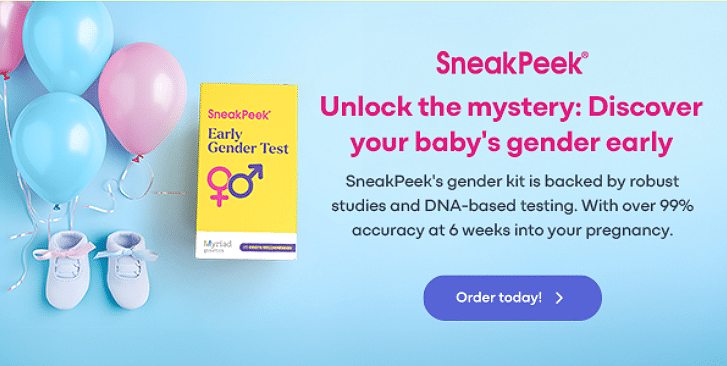Published on June 11th, 2025
Check out SneakPeek Gender Test to find out your baby’s gender as early as 6 weeks with over 99% accuracy!

Although a milestone in the prenatal journey, it’s easy to forget that the ultrasound has only been a standard of care since the 1970s. For generations of expecting parents, the first sight of that tiny black-and-white fuzzball on the ultrasound was one of the most moving moments of their pregnancy journey.
Today, parents can see that fuzzball in motion: 4D ultrasounds allow you to watch your baby wiggle live in the womb, while 3D ultrasounds add more dimension to the traditionally flat image. But while adding dimension (literally) can make your baby feel that much more real, 3D and 4D scans still aren’t considered a medically necessary part of prenatal care.
If you’re considering having a high-tech fetal ultrasound, it’s a good idea to understand the uses and potential drawbacks before getting one. Here, we’ll compare the three types of ultrasound for pregnancy—2D, 3D, and 4D—so you can make the best possible choice for you and your family.
Ultrasound Types At-A-Glance: 2D, 3D, and 4D
If you’ve seen an IMAX movie or have an art history degree, you may be able to guess the main difference between 2D, 3D, and 4D ultrasounds:
- 2D ultrasounds produce a flat, two-dimensional picture of your baby and uterus
- 3D ultrasounds add depth to the image, producing a three-dimensional ultrasound scan
- 4D ultrasounds capture a fetus’ motion in utero, producing real-time footage of your growing baby
Summing up, the key difference between 2D, 3D, and 4D ultrasounds has to do with their level of detail. For clinical purposes, this can be useful for detecting certain developmental abnormalities (like a cleft palate) which may be visible on 3D ultrasounds, and harder to see on 2D ultrasound scans.
That said, there is currently no medical consensus declaring 3D or 4D ultrasounds more beneficial than 2D ones. In fact, higher-tech ultrasounds may introduce some risks that routine ultrasounds don’t—and it’s important for expecting parents to know why.
What are 2D ultrasounds?
2D ultrasounds are considered a standard, necessary component in prenatal care. However, you may not know that the images they produce are actually made by sound waves.
You may have previously wondered “Is a sonogram the same as an ultrasound?” While the ultrasound refers to the procedure itself, a sonogram refers to the image that an ultrasound yields. Here’s how it’s all done:
- A sonographer uses a device called a transducer to send high-frequency sound waves toward the uterus or abdomen.
- These waves make contact with physical internal structures and organs, then echo back to the device. These echoes travel at different speeds, depending on the density of the internal structures they meet.
- A computer receives the returning echoes and interprets them to render a picture of the patient’s internal structures. This includes the uterus (and, if applicable, any abnormalities detected), as well as its contents—i.e. the fetus.
The result is a two-dimensional, black-and-white picture of a growing baby.
Clinicians primarily use 2D ultrasounds to:
- Confirm a pregnancy
- Check for a fetal heartbeat and heart rate
- Measure the fetus
- Check the fetus’ position in the womb
- Estimate a fetus’ gestational age
- Screen for developmental abnormalities
- Screen for multiples
- Predict a baby’s due date
- Predict a baby’s sex
- Check amniotic fluid levels
All of this is crucial information for both the expecting parent and their doctor to prepare for the healthiest pregnancy possible.
Are 2D ultrasounds necessary?
In short—yes.
2D ultrasounds are considered a medical necessity for expecting parents and a pillar of prenatal health. It’s recommended that expecting parents get one at around the 20-week mark of their pregnancy journey.
Ultrasounds are also extremely safe. Rest assured that the sound waves produced by ultrasounds do not hurt the baby.
What are 3D ultrasounds?
In contrast to 2D ultrasounds, 3D ultrasounds are voluntary. They’re a more advanced type of imaging—requiring more sophisticated, specialized equipment and computer software—that yields a three-dimensional picture of your developing baby.
Because 3D ultrasounds provide more refined images, they may allow for more visual detail.
Benefits and Drawbacks
The main benefit of 3D ultrasounds is their potential to display your developing baby in more detail. For some expecting parents, this deepens the emotional bond they feel with their child, or can provide a level of reassurance they wouldn’t feel looking at a standard fetal ultrasound.
On the other hand, 3D ultrasounds are less widely available and more costly than standard 2D ones—and they aren’t covered by insurance plans. This may make them inaccessible for budget-conscious expecting parents, or those who are relying strictly on their insurer for prenatal care.
What are 4D ultrasounds?
4D ultrasounds are like 3D ones, with one added variable: time. With a four-dimensional ultrasound, you can see your baby in utero and in action with real-time video footage.
Benefits and Drawbacks
Like 3D ultrasounds, 4D ultrasounds provide an incredible level of detail. While some commercial or non-medical facilities may offer 3D and 4D ultrasounds, many OB/GYN offices also perform these scans using high-quality equipment and trained professionals. In fact, many practices include 3D imaging as part of their standard prenatal offerings, either complimentary or for a nominal fee.
For instance, the US Food and Drug Administration cites two points of caution for both three- and four-dimensional ultrasounds:
- Ultrasound exposure – Standard, 2D ultrasounds are considered safe and effective procedures. Despite no reliable evidence of harm to mothers and their babies using current ultrasound technologies, casual (or non medically-indicated) use of ultrasound is not recommended.
- Technician competency –. If you’re seeking 3D or 4D ultrasounds from a commercial provider, it’s a good idea to confirm that the technician is well-trained and uses FDA-cleared equipment. When performed in a medical setting, these scans are overseen by licensed professionals.
Choosing the Best Ultrasound Type for You
Whether or not you’re seriously considering a 3D or 4D ultrasound, it’s important to include a traditional, two-dimensional one in your prenatal care plan.
Remember, 2D ultrasounds are medically necessary, while 3D ultrasounds have some medical capabilities. 4D ultrasounds, on the other hand, aren’t considered medically valuable and are strictly voluntary.
Apart from necessity, the main differences between these three types of procedures are:
- Visual detail – 2D ultrasounds display enough visual information to help clinicians diagnose any existing abnormalities or potential complications. 3D ultrasounds are more detailed static images, while 4D ultrasounds display the same detail in motion. If seeing more of your baby is important to you, a 3D or 4D ultrasound scan could be worth considering.
- Accessibility – 2D ultrasounds are considered part and parcel with prenatal care, so they’re offered by medical providers and typically covered by insurance plans. 3D and 4D ultrasounds are offered by specialized businesses, and they can be harder to find if you live in a more rural area.
- Cost – So, how much does an ultrasound cost expecting parents? Standard ultrasounds are usually paid for by insurance. 3D and 4D ultrasounds, conversely, are elective, which means you’ll probably pay out of pocket. While costs can vary, many OB/GYN offices offer 3D and 4D ultrasounds at accessible rates—some as low as $100 to $150—depending on your location and provider.
When to Get a 2D Pregnancy Ultrasound
Given the numerous types of ultrasounds and their various uses, it’s not always clear when you should schedule your 2D ultrasound. For most clinicians—and for most pregnancies—only one ultrasound is absolutely necessary: the anatomy scan, administered during the second trimester between 18 and 22 weeks.
That said, first-trimester ultrasounds and third-trimester ultrasounds can also be useful, particularly if your pregnancy falls into a special category. So, at what weeks do you get ultrasounds during pregnancy?
First-Trimester Ultrasounds
First-trimester ultrasounds are often used to confirm a pregnancy by scanning for a fetal heartbeat. However, as many people use at-home pregnancy tests to determine their status, it’s less common to have one in the first trimester.
That said, your healthcare provider may recommend an early scan, like a 12-week ultrasound or even a 6 to 8 week ultrasound, on certain occasions:
- High-risk pregnancies – If you have a history of pregnancy complications—like ectopic pregnancy or pregnancy loss—your healthcare provider may want to evaluate a pregnancy’s viability early on.
- Risk of developmental anomalies – Certain pregnancies may be naturally higher risk than others, like conceiving over the age of 35 or having a genetic predisposition to chromosomal disorders. In these cases, your healthcare provider may recommend an early ultrasound.
Likewise, symptoms like disruptive pelvic pain or abdominal cramping could prompt your healthcare provider to conduct an early pregnancy ultrasound.
Third-Trimester Ultrasounds
It’s not typical to conduct an ultrasound in the third trimester, but if your healthcare provider suggests one it could be related to:
- Your baby’s size – If your baby is atypically small or large for their gestational age, your doctor may want to take a closer look at how they’re developing.
- Your baby’s position – Head-down, facing the back of your body (also called occiput or cephalic anterior) is considered the best for a smooth birthing process. If your due date is nearing and your healthcare provider suspects your baby is in a different position, they may want to conduct an ultrasound to check.
- Your reproductive health – Conditions impacting the placenta’s placement (e.g. placenta previa) or amniotic fluid levels could warrant a late-trimester ultrasound.
Get a Closer Look at Your Newest Addition with the SneakPeek Test®
In the weeks leading up to your due date, it’s recommended to schedule semi-weekly prenatal appointments starting at 28 weeks. Whether or not you watch your baby’s progression via an ultrasound—2D, 3D, or 4D—it’s always possible to meet your little “fuzzball” earlier with the SneakPeek test.
The SneakPeek Early Gender Test is a simple-to-use method for learning your baby’s predicted sex weeks before your gender reveal ultrasound. More than 1 million parents have already used SneakPeak’s patented technology to discover their baby’s predicted sex as soon as 6 weeks into gestation and with over 99% clinically accuracy.
Whether you’re eager to learn how to test gender for twins or you’re simply itching to plan a gender reveal or nesting party, SneakPeak can bring you one step closer to planning for your little one. Learn why the SneakPeek test is the #1 OBGYN-recommended at-home early sex prediction test* by ordering yours today.
*SneakPeek recommended six to one among 100 OBGYNs survey
Editorial Policy
At SneakPeek, our commitment is to provide accurate, up-to-date, and reliable information to empower our readers. Our content is thoroughly researched, reviewed by medical experts, and fact-checked to ensure its credibility. We prioritize the well-being and education of our readers, and our editorial policy adheres to the highest standards of integrity and accuracy in all our articles.
This post has been reviewed for accuracy by the following medical professional:
Dr. Stitt is a board-certified OB/GYN with over 20 years of experience providing compassionate care to women throughout every stage of pregnancy and childbirth. She is currently the medical director for a large group practice in Annapolis, Maryland and is actively involved in training both OB/GYN residents and medical students. Dedicated to patient education and empowerment, Dr. Stitt is passionate about helping women make informed decisions about their health, from prenatal care to postpartum recovery. Known for a warm and supportive approach, Dr. Stitt strives to create a positive and reassuring experience for expectant mothers, ensuring they feel confident and well-prepared for the journey of motherhood.
Sources:
- Live Science. 5 Fascinating Facts About Fetal Ultrasounds. https://www.livescience.com/32071-history-of-fetal-ultrasound.html
- Cleveland Clinic. Ultrasound. https://my.clevelandclinic.org/health/diagnostics/4995-ultrasound#what-is-an-ultrasound
- Parents. What to Expect at Your First Ultrasound During Pregnancy. https://www.parents.com/pregnancy/my-baby/your-babys-first-ultrasound/
- GoodRx. How Much Does an Ultrasound Cost Without Insurance? https://www.goodrx.com/health-topic/diagnostics/ultrasound-cost-without-insurance
- Parents. Why Pregnancy Ultrasounds Are Done, Week by Week. https://www.parents.com/pregnancy/stages/ultrasound/ultrasound-a-trimester-by-trimester-guide/#toc-second-trimester-ultrasound
- National Library of Medicine. Sonography 1st Trimester Assessment, Protocols, and Interpretation. https://www.ncbi.nlm.nih.gov/books/NBK573070/
- Cleveland Clinic. Fetal Positions. https://my.clevelandclinic.org/health/articles/9677-fetal-positions-for-birth
- Obstetrics & Gynecology. ISUOG Practice Guidelines: performance of third-trimester obstetric ultrasound scan. https://obgyn.onlinelibrary.wiley.com/doi/10.1002/uog.27538
- BabyCenter. Everything you need to know about 3D and 4D ultrasounds during pregnancy. https://www.babycenter.com/pregnancy/health-and-safety/3d-and-4d-ultrasound_40007980
- UT Southwestern Medical Center. Why to avoid ‘keepsake’ 3-D and 4-D ultrasounds. https://utswmed.org/medblog/3d-4d-ultrasound/NIH. For – 3D ultrasound in first and second trimester – hype or helpful? https://pmc.ncbi.nlm.nih.gov/articles/PMC5024839/








